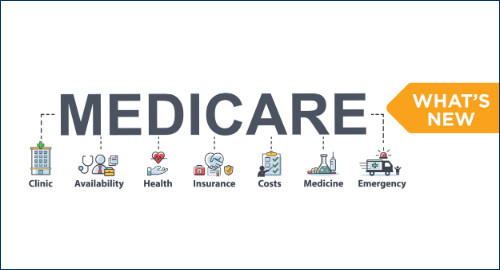Filling in the gap – MedSupp vs. Medicare Advantage
Original Medicare (Parts A and B) is great basic healthcare coverage for adults ages 65 and older, but it does leave significant coverage gaps. These include expensive deductibles and co-payments for hospital stays and doctors’ visits and no coverage for prescription drugs or services like routine dental and vision care. There is also no out-of-pocket maximum for Medicare, meaning the more services you use, the more your expenses could mount up. With this in mind, one of the biggest decisions that you might have is whether to buy a Medicare supplemental insurance plan (aka MedSupp or Medigap) or enroll in a Medicare Advantage (MA) plan. You can’t have both, so the decision is important.
Let’s break down some of the key differences between MedSupp vs. Medicare Advantage and what they might mean for you:
1. Benefit offerings
Medigap policies are labeled Plans A, B, C, D, F, G, K, L, M and N and their coverage is standardized. This means that if you are looking for a plan, you can compare prices across insurers and choose which one works best for you. With Medicare Advantage plans, each plan has different benefits and rules, but they cover services, such as office visits, lab work, surgery and many others after a small co-pay. They also include extra benefits such as dental transportation, chiropractic, acupuncture and fitness options.
Note: Congress recently suspended Medigap plans C and F for all newly eligible beneficiaries starting in 2020. Plan F provided the strongest, most comprehensive coverage, including paying for the Medicare Part B deductible.
2. Costs
If you choose Original Medicare, plus a Medigap plan, plus a Part D prescription drug policy, this means three kinds of coverage with a premium for each. Medicare Advantage plans typically have lower premiums and also offer the convenience of having one policy, rather than juggling three different types of coverage. When it concerns costs, a Medicare Advantage plan may be a better choice based on the out-of-pocket maximum that could protect you from high medical bills.
Note: If you enroll in a Medigap plan, your premium could rise as you get older in most states, including California, where there are no community ratings. According to Barron’s, someone in their 80s will be paying 50 percent more than a 65-year-old.
3. Provider networks
Traditional Medicare plus a Medigap insurance plan usually allows more choice in where you receive your care. Many Medicare Advantage plans require you to use their network and may cover less, or none, of the expenses of using out-of-network providers. However, this also offers the benefit of having coordinated care; your primary care doctor will be kept be in the loop about finding and referring you to a specialist. An entire team will connect the dots for you.
Note: Aspire Health Plan members can receive care at any hospital in Monterey County. Our plan network also includes over 700 doctors and many other healthcare providers.
4. Prescription drug coverage
If you choose a Medigap plan, you should also sign up for a Medicare Part D prescription drug plan. Although Medicare Part D prescription drug coverage is optional, if you don’t get it as either as a stand-alone plan or as part of a Medicare Advantage plan there could be financial penalties. Most who sign up for a Medicare Advantage plan receive drug coverage as part of the plan, known as an MAPD plan. When shopping for an MAPD plan, be sure to check whether prescription drug benefits are included.
Note: All Aspire Health Plan options include Part D coverage.
5. Emergency care abroad
Original Medicare does not cover care you receive while traveling outside of the U.S., except for very limited circumstances (such as on a cruise ship within six hours of a U.S. port). Some Medigap policies cover of the cost of emergency care abroad, but with a lifetime limit. Some Medicare Advantage plans cover emergency care abroad.
Note: At Aspire Health Plan, with all three of our plans, you are secure in knowing you’re covered anywhere in the United States for urgent or emergent care when traveling. You can always contact Member Services at (855) 570-1600 if you have specific questions about travel. TTY users call 711.
It’s a tough choice, we know. Consider benefits needs, costs, choice of doctors, lifestyle factors and your overall health when choosing the best Medicare coverage for your healthcare needs.
Turning 65 soon? Get all of the information you need when you request a Welcome to Medicare kit.
H8764_MKT_MA-MedSupp_Blog_0920_C











[…] These are two different types of plans, and you cannot have both Medicare Advantage and MedSupp coverage. Medigap plans fill in coverage gaps in Original Medicare. Generally, they have higher monthly premiums than HMO or HMO-POS Medicare Advantage plans, but you can see any doctor who accepts Medicare. With a Medigap plan, you will need to purchase a separate prescription drug plan (Part D) if you want prescription drug coverage. We go into more detail in a previous blog post. […]
[…] insurance plan (aka MedSupp or Medigap) or an MA plan. (We compare the two in a previous blog post.) All Medicare Advantage plans have limits on your out-of-pocket costs. These amounts vary by […]
Basic Medicare Supplement is a higher monthly premium plan. One would benefit from this plan if they did not like co-pays or co-insurance. When you go to the doctor, you do not have to pay a co-pay for a visit. Learn more https://www.patriotinsurancebrokers.com/blog/medicare-supplement/
Medicare Advantage plans go beyond Original Medicare with better cost sharing for more services, a maximum out-of-pocket (MOOP), extra benefits, and additional support. Learn more https://www.patriotinsurancebrokers.com/blog/medicare-advantage-plan/
I am 68 and only receive $12,000 a year. I need dentures and glasses and can’t afford a high premium. In my zip code I don’t qualify for reasonible plan. What do I do?